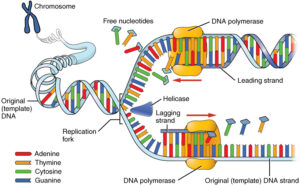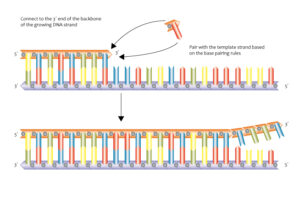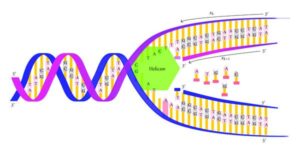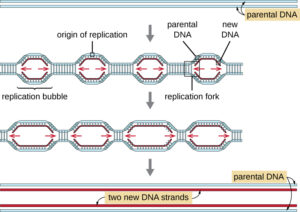DNA replication is a process in which the DNA makes its own copies or duplicates itself during the process of the division of cells. This DNA replication is a semiconservative process.
Now, what is the semiconservative DNA replication process and what are the steps involved in it. The DNA replication process includes Initiation, Elongation and termination. It starts from the recognition of the site of the replication and includes various steps and concludes it by joining the DNA fragment molecules.
This article will focus on the detailed information on each and every part of the DNA replication process.
So, we know that DNA is a genetic material which carries the genetic information and passes from one generation to another.
DNA is a double stranded organic molecule consisting of a pentose sugar molecule, phosphate molecule and 4 nitrogenous bases paired. Adenine pairs with thymine and cytosine with guanine.
Each of these molecules have the genes that code for a specific amino acid and provide the genetic information.

Image Credits- Wikimedia
What is a Semiconservative DNA replication process?
We know that DNA replication is a process in which 1 strand replicates itself and makes copies out of it.
DNA is a double strand and has a nitrogenous base( A, T, G, C), a pentose sugar molecule- Deoxyribose sugar, a highly negative phosphate molecule. So during replication of the initial strand of DNA, one strand is retained and the other strand is made by adding the specific nucleotides to it.
So one is the newly formed strand of DNA (Addition of nucleotides) and the other strand is the retained old DNA strand which is called the template strand.
Example: The template strand of DNA is
A T T G C A T A G G G G C C T T T A A C C T G G C A T A G G T T T A A A C C C G G G G A G G G G C C T T T A A C C T G G C A T A G G
The newly formed complementary strand of DNA will be
T A A C G T A T C C C C G G A A A T T G G A C C G T A T C C A A A T T T G G G C C C C T C C C C G G A A A T T G G A C C G T A T C C

Image credits- Wikimedia
Read More on Is Cyano bacteria Unicellular Or Multicellular: Why, How And Detailed Insights
What are the steps in the semiconservative DNA replication process?
The semiconservative DNA replication process includes 3 steps.
Initiation:
- This is the process in which the DNA replication starts or initiates.
- The enzyme called helicase that is responsible for the recognition of the ORIC– Origin of replication binds to the DNA strand and unwinds or separates the double stranded DNA molecule.
- The end product of the step/ stage/ phase is the 2 strands of the double stranded DNA becoming 2 separate DNA strands, but not completely.
- The half of the strand remains as the double strand as they do not participate at that positive moment, thus producing a fork-like structure called the replication fork.
Read More on Is Fungi Multicellular Or Unicellular: Why, How And Detailed Insights And Facts

Image credits- Wikimedia
Elongation:
- Addition of RNA nucleotides by the primer takes place here to the template DNA strand.
- Another enzyme called Primase produces a small strand of RNA to which the next enzyme identifies and binds.
- The 3’ to 5’ direction of the strand is called the leading strand.
- The 5’ to 3’ direction of the strand is called the lagging strand.
- This addition of nucleotides is done by a specific enzyme called the DNA polymerase which adds the nucleotide that complements the template DNA.
- The DNA polymerase does not have the capacity to produce or synthesize a new strand, it can only add to a pre existing strand.
- Finally, the RNA nucleotides will be replaced by DNA nucleotides by enzymes called exonucleases FEN1 and RNase H.
- So when Adenine is present, thymine is added and guanine is present, cytosine is added- vice versa.
Termination:
- Now, the synthesis of new strands must stop at a point. When the termination point has reached, the DNA polymerase stops the addition of nucleotides.
- The DNA polymerase does not have the ability to create a bond in between to combine it.
- The enzyme ligase combines the strand by creating a phospho-di-ester bond into the DNA molecule thus that strands get combined.

Image credits- Wikimedia
Read More on Adenosine nucleoside and nucleoside phosphoramidite | Overview of important aspects
Summary of steps in the semiconservative DNA replication process:
The actual and the well known steps in the semiconservative DNA replication is the Initiation, elongation, termination process. The much more simplified version is
- Recognition of the site or origin of replication
- Dissociation or unwinding of DNA strands.
- Addition of the nucleotides
- Synthesis of a new strand of DNA
- Termination of the synthesis process
- Combining of the strands by enzymatic process
Read More on Biosynthesis of Purines and Pyrimidines | An important part of cellular metabolism
So 1 double strand of DNA becomes 2 double stranded DNA molecules Each strand has 1 template and one newly synthesized dna that complements the Template DNA.

Image Credits- Wikimedia
Read More on Nucleotide Excision Repair and Single Nucleotide Polymorphism | An Important discussion
What are the enzymes that are responsible for the Semiconservative DNA replication process?
- DNA Helicase Enzyme – DNA Helicase aids in the unwinding of the double stranded DNA.
- Primase Enzyme – Addition of a short RNA primer
- DNA polymerase Enzyme – Addition of the new nucleotides
- Exonucleases Enzyme FEN1 Enzyme and RNase H Enzyme – Removal of the RNA nucleotides formed initially.
- Enzyme Ligase– Combine the 2 separate DNA strands to one making it double stranded DNA.
Also Read:
- Is primary transport active
- Is enzyme a catalyst
- Functions of mitochondria
- Obligate anaerobes
- Arachnid types
- Nucleic acid
- Coliform bacteria examples
- Domain bacteria examples
- Obligate parasites examples
- Dna transcription enzyme

Hello, I am Sugaprabha Prasath, a Postgraduate in the field of Microbiology. I am an active member of the Indian association of applied microbiology (IAAM). I have research experience in preclinical (Zebrafish), bacterial enzymology, and nanotechnology. I have published 2 research articles in an International journal and a few more are yet to be published, 2 sequences were submitted to NCBI-GENBANK. I am good at clearly explaining the concepts in biology at both basic and advanced levels. My area of specialization is biotechnology, microbiology, enzymology, molecular biology, and pharmacovigilance. Apart from academics, I love gardening and being with plants and animals.
My LinkedIn profile-